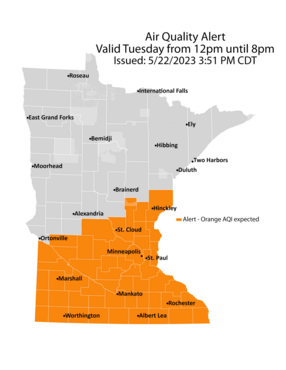|
|
View this as a webpage
Air quality alert issued due to ozone for Tuesday, May 23, for southern Minnesota

The Minnesota Pollution Control Agency (MPCA) has issued an air quality alert for southern Minnesota, from 12 p.m. through 8 p.m. Tuesday, May 23. The affected area includes the Twin Cities metropolitan area, St. Cloud, Rochester, Mankato, Marshall, and the tribal nations of Mille Lacs, Upper Sioux, and Prairie Island.
Ground-level ozone is expected to be high during the afternoon hours on Tuesday, and air quality is expected to reach the Orange (unhealthy for sensitive groups) AQI category across southern Minnesota. Southerly winds are transporting pollutants into the state. Sunny skies, warm temperatures, and low humidity will allow these pollutants to react in the air to produce ground-level ozone. Ozone will be highest during the afternoon and early evening hours when sunshine is most abundant, and temperatures are highest. Air quality is expected to reach the Orange AQI category. This is considered unhealthy for sensitive groups.
|
|
|
|
People whose health is affected by unhealthy air quality: There are people who are more likely to be affected when ozone pollution reaches an unhealthy level.
-
People who have asthma or other breathing conditions like chronic obstructive pulmonary disease (COPD), chronic bronchitis, and emphysema.
-
Children and teenagers.
-
People of all ages who are doing extended or heavy, physical activity like playing sports or working outdoors.
- Some healthy people who are more sensitive to ozone even though they have none of the risk factors. There may be a genetic base for this increased sensitivity.
Health effects: Unhealthy ozone levels can aggravate lung diseases like asthma, emphysema, and COPD. When the air quality is unhealthy, people with these conditions may experience symptoms like difficulty breathing deeply, shortness of breath, throat soreness, wheezing, coughing, or unusual fatigue. If you are experiencing any of these symptoms, use your inhalers as directed and contact your health care provider.
Take precautions: Everyone should take precautions when the air quality is unhealthy.
-
Take it easy and listen to your body.
-
Limit, change, or postpone your physical activity.
-
If possible, stay away from local sources of air pollution like busy roads and wood fires.
-
If you have asthma, or other breathing conditions like COPD, make sure you have your relief/rescue inhaler with you.
-
People with asthma should review and follow guidance in their written asthma action plan. Make an appointment to see your health provider if you don’t have an asthma action plan.
Pollution reduction tips: Ozone is produced on hot, sunny days by a chemical reaction between volatile organic compounds and oxides of nitrogen.
-
Reduce vehicle trips and fill-up the gas tank at dawn or dusk.
-
Encourage use of public transport, or carpool, when possible.
-
Postpone use of gasoline powered lawn and garden equipment on air alert days. Use battery or manual equipment instead.
-
Avoid backyard fires.
|
|
|
|
